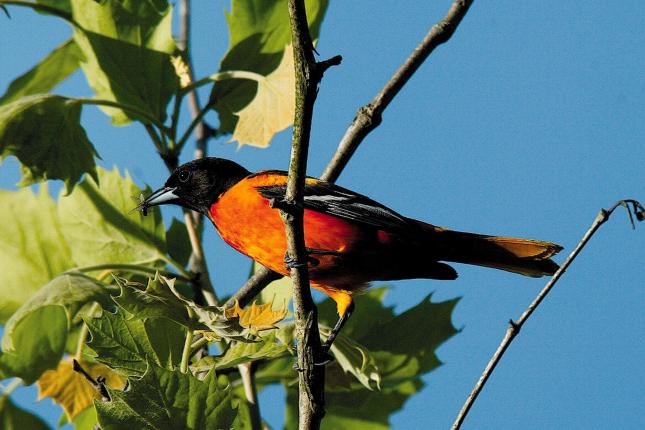
Attracting Baltimore Orioles to Your Yard !
In search of an adequate food supply to raise a family, thousands of Baltimore Orioles migrate from Central America to Michigan during springtime. What does it take to attract these vibrantly plumaged orange and black birds to our yard?
Orioles are known to enjoy grape jelly, mealworms and oranges offered in specialty feeders. Nectar feeders can also be used. Boil one cup of water; add 1/4 cup of sugar; cool and fill the feeder. Be patient and keep the foods fresh, replacing them every few days. Be sure to keep your feeders clean, too.
Fun Facts About Baltimore Orioles
- When not feeding on nectar, orioles seek out caterpillars, fruits, insects, and spiders. Unlike many insect eating birds, Baltimore Orioles will eat spiny or hairy caterpillars, including such pest species as fall webworms, tent caterpillars, and gypsy moths.
- Most male Baltimore Oriole songs vary enough from one another as to be unique to each individual. It is believed females can identify and locate their mate by its distinct song.
- The Baltimore Oriole is a common inhabitant of suburban landscapes due to is preference for open settings that are bordered with mature trees.
- The Oriole nest is an engineering masterpiece. They weave a hanging-basket nest with plant fibers, grasses, vine and tree bark and sometimes string or yarn placed out on the small twigs of a branch 6-45 feet in the air. This keeps them safe from most predators.
The female Baltimore Oriole builds her nest with little or no help from its mate. Only the female incubates and broods, both feed the young. - Orioles will lay 4-5 eggs anywhere from April to June. The young will fledge as late as 30 days from egg laying.
- Most Baltimore Orioles spend their winters in southern Mexico, Central America and the tropics, but some will stay in the southern states of the U.S., with a few reports as far north as New England.
- The oldest banded Baltimore Oriole recaptured in the wild had lived 11 years and 7 months.
A Dream of a Weaver
Many of us dream of having an oriole take up residence in our yard or neighborhood. To behold a brilliant-colored male flashing like a burst of fire from branch to branch, while serenading us with its uplifting whistles, it’s a cause for celebration!
Typically woven out of plant fibers, the oriole’s hanging basket nest is truly an engineering masterpiece. It takes up to two weeks to complete the six inch deep nest, with the female investing over 40 hours to weave more than 10,000 stitches and tying together thousands of knots - all skillfully done with her beak alone.

